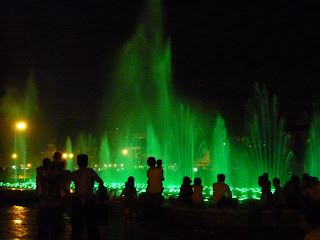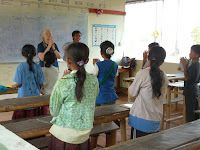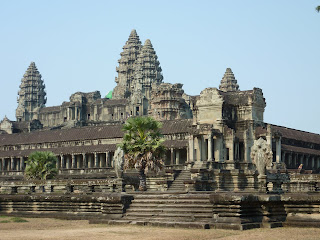Finally, the event that brought us all the way to Cambodia - we got to visit Roteang orphanage and village. What a delight.
 Elephant, the center director, picked us up at our hotel Saturday morning in his car. No tuk tuk today! As he drove us out to Roteang village, he told us more about the project. It was started by a pediatrician from New England, Nancy Hendrie. In 1998 or so she traveled through Cambodia, visiting orphanage after orphanage to provide medical care. Elephant was her driver, as she worked 12 hour days and saw hundreds of kids. After that trip, she decided that more had to be done, so she started the Sharing Foundation. In 2000, it opened an orphanage in Roteang, about 30 minutes from Phnom Phen. I get the sense that it was meant to both offer excellent care to some of the children with the greatest need in Cambodia, but also to serve as an example of what orphanage care could and really should be.
Elephant, the center director, picked us up at our hotel Saturday morning in his car. No tuk tuk today! As he drove us out to Roteang village, he told us more about the project. It was started by a pediatrician from New England, Nancy Hendrie. In 1998 or so she traveled through Cambodia, visiting orphanage after orphanage to provide medical care. Elephant was her driver, as she worked 12 hour days and saw hundreds of kids. After that trip, she decided that more had to be done, so she started the Sharing Foundation. In 2000, it opened an orphanage in Roteang, about 30 minutes from Phnom Phen. I get the sense that it was meant to both offer excellent care to some of the children with the greatest need in Cambodia, but also to serve as an example of what orphanage care could and really should be. Check out their website, http://www.sharingfoundation.org/ . In particular, take a look at the video on their home page. It's only about 7 minutes, but it's excellent. In the past 10 years, the Sharing Foundation has expanded way beyond just the orphanage. They now run all sorts of programs for the village kids, including English classes, computer classes, sewing school, mechanic training, high school and college sponsorships, and programs to get village kids to school.
Check out their website, http://www.sharingfoundation.org/ . In particular, take a look at the video on their home page. It's only about 7 minutes, but it's excellent. In the past 10 years, the Sharing Foundation has expanded way beyond just the orphanage. They now run all sorts of programs for the village kids, including English classes, computer classes, sewing school, mechanic training, high school and college sponsorships, and programs to get village kids to school. On our visit, we first stopped in the fields. Workers were hauling water and weeding, while their kids attended school in two simple rooms right near the field. That's the way the program works: the foundation rented land for farming, which is available to families in the village IF they send their kids to school. That's the only requirement.
On our visit, we first stopped in the fields. Workers were hauling water and weeding, while their kids attended school in two simple rooms right near the field. That's the way the program works: the foundation rented land for farming, which is available to families in the village IF they send their kids to school. That's the only requirement. Next we stopped at the sewing school. I thought that was particularly interesting since I like to sew myself. The "school" building is simple - just an ordinary village house. The upstairs is one room, filled with 4-5 treadle sewing machines, a serger, and space to cut. Girls learn to make "simple" clothes first - mostly school uniforms. I always think that's funny when I hear it - I think that tailored shirts are pretty advanced! They also make beautiful bags which are sent back to New England to be sold, profits coming right back to the village.
Next we stopped at the sewing school. I thought that was particularly interesting since I like to sew myself. The "school" building is simple - just an ordinary village house. The upstairs is one room, filled with 4-5 treadle sewing machines, a serger, and space to cut. Girls learn to make "simple" clothes first - mostly school uniforms. I always think that's funny when I hear it - I think that tailored shirts are pretty advanced! They also make beautiful bags which are sent back to New England to be sold, profits coming right back to the village. Then we headed to the orphanage itself. It was lovely. Once through the gate, we parked, and saw a clearing with buildings on three sides. On the right was a tiled building for the Montessori pre-school. On the left was the new Mary Jane dorm building. And straight ahead was the original building where the babies sleep in "dorms" (large rooms for mats). The main building has a wide tiled porch where a bunch of kids and their nannies were hanging out. We handed over the pile of children's books we'd painfully lugged from the U.S., and were gratified to see kids slowly swarm over to pour over the new offerings. There was already a couple bins of books out for them, but I know I always want new books!
Then we headed to the orphanage itself. It was lovely. Once through the gate, we parked, and saw a clearing with buildings on three sides. On the right was a tiled building for the Montessori pre-school. On the left was the new Mary Jane dorm building. And straight ahead was the original building where the babies sleep in "dorms" (large rooms for mats). The main building has a wide tiled porch where a bunch of kids and their nannies were hanging out. We handed over the pile of children's books we'd painfully lugged from the U.S., and were gratified to see kids slowly swarm over to pour over the new offerings. There was already a couple bins of books out for them, but I know I always want new books! Out behind the main building was the kitchen, eating hall, and a beautiful playground that Elephant brought in from Thailand. I have no idea how he got it into a vehicle, but people are very creative at hauling things in this country! The kids eat in little clusters with their nannies, on mats. I think that's a pretty traditional way to eat in Cambodia - we saw families eating that way later in the night market in Phnom Phen. And out back we saw the laundry. Imagine laundry for 84 kids and their nannies! Each nanny does laundry for "her" kids. It's quite a measure of the quality of Roteang that each nanny only has 2 children, and only 1 for special needs kids. The nannies stay for a long time, so they really end up acting just like parents. It's a pretty good life for both the kids and the nannies, I think.
Out behind the main building was the kitchen, eating hall, and a beautiful playground that Elephant brought in from Thailand. I have no idea how he got it into a vehicle, but people are very creative at hauling things in this country! The kids eat in little clusters with their nannies, on mats. I think that's a pretty traditional way to eat in Cambodia - we saw families eating that way later in the night market in Phnom Phen. And out back we saw the laundry. Imagine laundry for 84 kids and their nannies! Each nanny does laundry for "her" kids. It's quite a measure of the quality of Roteang that each nanny only has 2 children, and only 1 for special needs kids. The nannies stay for a long time, so they really end up acting just like parents. It's a pretty good life for both the kids and the nannies, I think.Also out back is their own school for the first and second graders. They found that the village school didn't do so well with that age group, so they set up their own classes. When we peeked in, the kids were hard at work. Between the Montessori pre-school and their own high-quality first and second grades, the orphans probably start school way ahead of most village kids! But that's great.
And finally, mom got to meet the students that she and Echo sponsor. They are village kids, not orphans. But after attending English classes for several years, kids are now eligible for high school scholarships. Without them, kids are lucky to attend the public school where the teachers may or may not show up, the classes have 70 or more students, and it's hard to get books. With the scholarships, kids go to "private" classes that only have 30 or so students, with decent teachers. The money also pays for their books, uniforms, and transportation to the high school. It's a good program. And it was fun to actually meet the kids. They were shy but fun to talk to.
After a tour of the new dorm building and a visit to the computer lab (PCs for most work, and one child/one laptops for word processing), we headed back to the city. We continue to be impressed. Apparently Cambodian officials are too - they complain that the orphanage is "too good." I'm sure it's inconvenient for this facility to be setting such a good example, when other orphanages struggle to have one nanny for maybe 8 children. But I think it's great. As they say in the video, this feels like just a drop in the bucket for the problems in Cambodia, but to these kids, both the orphans and the many, many kids in this and surrounding villages, this work changes their lives. Don't feel shy to donate to this organization - now that we've seen their work I'm even more impressed with how far they stretch each dollar and what good work they are doing.
After our visit, I had to buy a bouncy toy like these for Iana. I hope she likes it as much as these kids do!











































